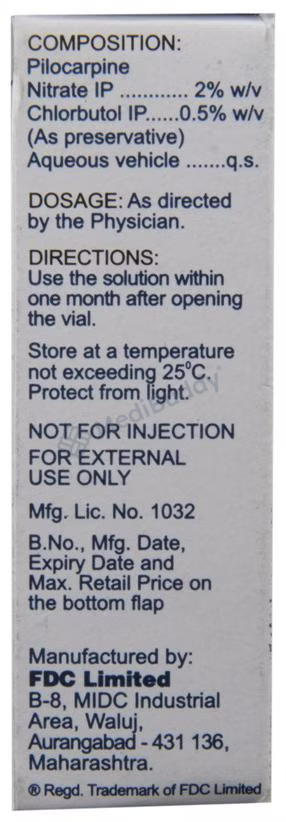Pilocar 2% Eye Drop
By Pilocar
5ml Eye Drop in a Bottle

Composition
Pilocarpine(2% w/v)

Manufacturer - FDC Ltd
FDC LIMITED, B-8, MIDC Area, Waluj - 431 136, Dist. Aurangabad, Maharashtra

Expires on or after
July, 2026

liver
Safety Advice - Liver Pilocar 2% Eye Drop does not have any known interactions with the liver according to available information. This means that there are no established risks or concerns specifically related to liver issues when using this eye drop. While this lack of interaction is positive, it is still important to exercise caution and consult a healthcare professional if you have any underlying liver conditions or concerns. Always follow the recommended dosage and usage instructions provided with the product. If you experience any unexpected symptoms or side effects related to your liver while using Pilocar 2% Eye Drop, seek medical advice promptly. If no information is available or safety advice is not known related to liver issues, give output "Consult with your doctor for proper guidance before using Pilocar 2% Eye Drop".

kidney
No interaction found/established.

alcohol
Safety Advice - Alcohol No interactions between Pilocar 2% Eye Drop and alcohol have been found or established.

driving
When using Pilocar 2% Eye Drop, be cautious while driving as it may cause difficulty in adapting to the dark and blurred vision, affecting your ability to drive.

pregnancy
Pilocar 2% Eye Drop may not be safe to use during pregnancy. Limited human studies suggest potential harm to the baby. Animal studies show harmful effects on fetal development. Your doctor will assess the risks and benefits before prescribing. Please consult your healthcare provider.

breastfeeding
During breastfeeding, it is likely safe to use Pilocar 2% Eye Drop based on limited human data showing no significant risk to the baby.
| Habit Forming | No |
| Chemical Class | Alkaloids Derivative |
| Therapeutic Class | - |
| Action Class | Cholinomimetic Alkaloids- Pilocarpine |
₹56.86
Inclusive of all taxes
Content verified by

Dr. Preeti Kumar
MBBS, DGO - Obstetrics and Gynaecology, DNB - Obstetrics and Gynaecology
Last update on 01-Oct-2024










